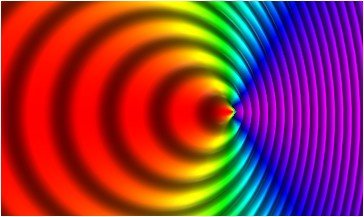Relativistic Doppler Effect
Consider a source emitting wave with original frequency \(f_0\), wavelength \(\lambda_0\) and wave speed \(c\), a receiver \(n\lambda_0\) apart from the source receiving the wave singal. When the receiver has no relative motion with the source, $$n\lambda_0 = cT_0,$$ where \(T_0\) is the time to travel from the light source to the receiver. Then the wavelength and frequency in terms of \(T_0\) are $$\lambda_0=\frac{cT_0}{n}$$ and $$f_0 = \frac{c}{\lambda_0}=\frac{n}{T_0}$$ respectively. Consider a receiver in an inertial frame that is moving at a speed \(v\) relative to the source frame and is towards the source. Then the distance apart is $$n\lambda = cT-vT,$$ where \(T\) is the time taken for the wave from the source to reach the receiver in the receiver frame. Then the wavelength in terms of \(T\) is $$\lambda=\frac{c-v}{n}T.$$ For the same event observed as in the inertial frame of the source, the time duration, \(T_0\), is $$T_0 = \frac{1}{\gamma}T$$ Thus, the frequency is \begin{align} \lambda &= \frac{c-v}{n}\gamma T_0 \\ f &= \frac{cn}{(c-v)\gamma T_0} \\ &= \frac{1}{\gamma(1-v/c)}f_0\\ &= \frac{\sqrt{1-v^2/c^2}}{1-v/c}f_0 \\ &= f_0 \sqrt{\frac{1+v/c}{1-v/c}} \end{align} Similarly, if the receiver is moving away from the source, one can substitute the speed \(v\) with \(-v\). Therefore, $$ \bbox[5px,border:2px solid #666] { f = f_0 \sqrt{\frac{1\pm v/c}{1\mp v/c}} } $$



Comments
Post a Comment